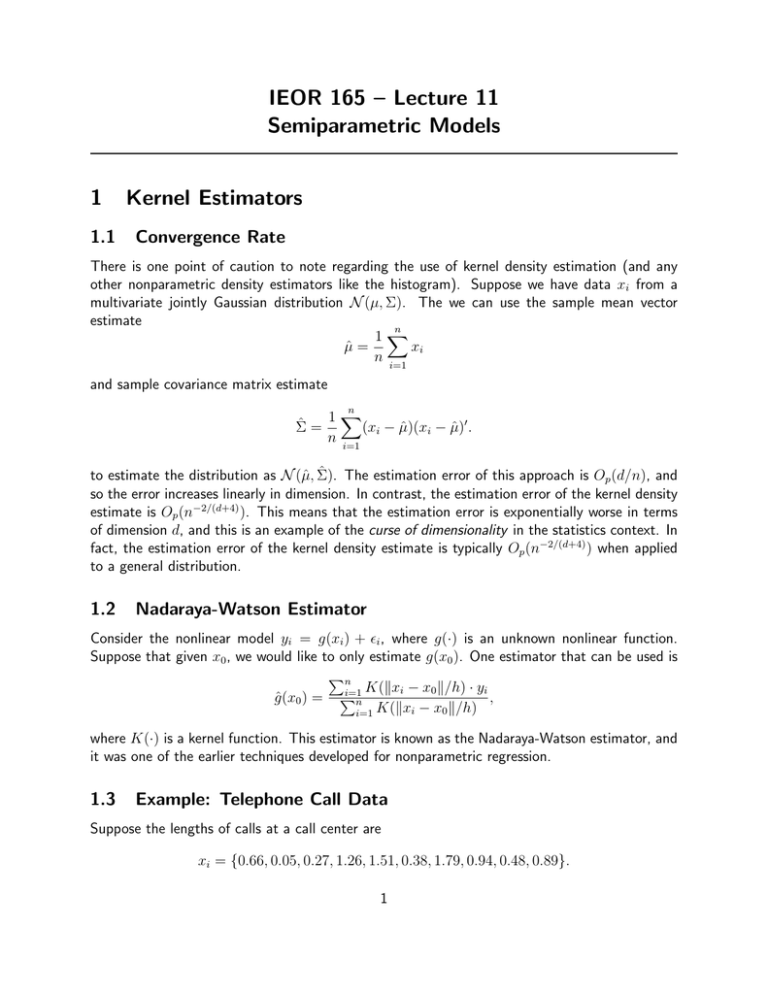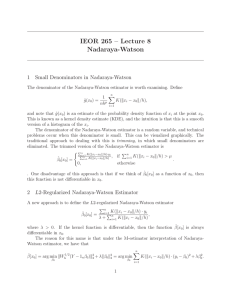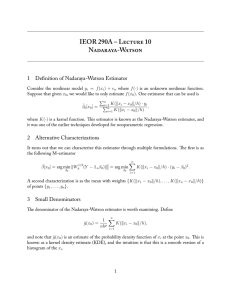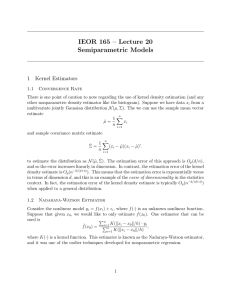IEOR 165 – Lecture 11 Semiparametric Models 1 Kernel Estimators
advertisement

IEOR 165 – Lecture 11
Semiparametric Models
1
1.1
Kernel Estimators
Convergence Rate
There is one point of caution to note regarding the use of kernel density estimation (and any
other nonparametric density estimators like the histogram). Suppose we have data xi from a
multivariate jointly Gaussian distribution N (µ, Σ). The we can use the sample mean vector
estimate
n
1X
xi
µ̂ =
n i=1
and sample covariance matrix estimate
n
1X
Σ̂ =
(xi − µ̂)(xi − µ̂)0 .
n i=1
to estimate the distribution as N (µ̂, Σ̂). The estimation error of this approach is Op (d/n), and
so the error increases linearly in dimension. In contrast, the estimation error of the kernel density
estimate is Op (n−2/(d+4) ). This means that the estimation error is exponentially worse in terms
of dimension d, and this is an example of the curse of dimensionality in the statistics context. In
fact, the estimation error of the kernel density estimate is typically Op (n−2/(d+4) ) when applied
to a general distribution.
1.2
Nadaraya-Watson Estimator
Consider the nonlinear model yi = g(xi ) + i , where g(·) is an unknown nonlinear function.
Suppose that given x0 , we would like to only estimate g(x0 ). One estimator that can be used is
Pn
i=1 K(kxi − x0 k/h) · yi
,
ĝ(x0 ) = P
n
i=1 K(kxi − x0 k/h)
where K(·) is a kernel function. This estimator is known as the Nadaraya-Watson estimator, and
it was one of the earlier techniques developed for nonparametric regression.
1.3
Example: Telephone Call Data
Suppose the lengths of calls at a call center are
xi = {0.66, 0.05, 0.27, 1.26, 1.51, 0.38, 1.79, 0.94, 0.48, 0.89}.
1
And imagine that we conduct a survey after each call where we ask the customer to rate their
satisfaction with the call. Suppose the corresponding satisfaction levels (1 = very dissatisfied, 2
= somewhat dissatisfied, 3 = neutral, 4 = somewhat satisfied, and 5 = very satisfied) are
yi = {3, 5, 4, 1, 1, 3, 2, 5, 4, 2}.
Q: Suppose we choose h = 0.5, and that we use the Epanechnikov kernel. Estimate the satisfaction level for a telephone call of length 0.7 using the Nadaraya-Watson estimator.
A: We first compute the quantities K
u−xi
h
for each data point. We have
K((0.7 − 0.66)/0.5) = K(0.08) = 3/4 · (1 − 0.082 ) = 0.7452
K((0.7 − 0.05)/0.5) = K(1.3) = 0
K((0.7 − 0.27)/0.5) = K(0.86) = 3/4 · (1 − 0.862 ) = 0.1953
K((0.7 − 1.26)/0.5) = K(−1.12) = 0
K((0.7 − 1.51)/0.5) = K(−1.62) = 0
K((0.7 − 0.38)/0.5) = K(0.64) = 3/4 · (1 − 0.642 ) = 0.4428
K((0.7 − 1.79)/0.5) = K(−2.18) = 0
K((0.7 − 0.94)/0.5) = K(−0.48) = 3/4 · (1 − 0.482 ) = 0.5772
K((0.7 − 0.48)/0.5) = K(0.44) = 3/4 · (1 − 0.442 ) = 0.6048
K((0.7 − 0.89)/0.5) = K(−0.38) = 3/4 · (1 − 0.382 ) = 0.6417
Finally, we compute
Pn
i=1 K(kxi − x0 k/h) · yi
ĝ(0.7) = P
=
n
i=1 K(kxi − x0 k/h)
0.7452 · 3 + 0.1953 · 4 + 0.4428 · 3 + 0.5772 · 5 + 0.6048 · 4 + 0.6417 · 2
= 3.41.
0.7452 + 0.1953 + 0.4428 + 0.5772 + 0.6048 + 0.6417
For reference, the scatter plot and the full curve ĝ(x) estimated by Nadaraya-Watson are shown
below. The full curve is generally calculated using a computer.
2
The Epanechnikov kernel is not differentiable, and so the estimated curve is not differentiable.
An example of a kernel function that is differentiable is the biweight kernel, which is defined as
K(u) =
15
· (1 − u2 )2 1(|u| ≤ 1).
16
If we use the biweight kernel, then the full curve estimated by Nadaraya-Watson is
This curve is differentiable.
3
1.4
Small Denominators in Nadaraya-Watson
The denominator of the Nadaraya-Watson estimator is worth examining. Define
n
1 X
K(kxi − x0 k/h),
ĝ(x0 ) =
nhp i=1
and note that fˆ(x0 ) is an estimate of the probability density function of xi at the point x0 . This
is known as a kernel density estimate (KDE), and the intuition is that this is a smooth version of
a histogram of the xi .
The denominator of the Nadaraya-Watson estimator is a random variable, and technical problems
occur when this denominator is small. This can be visualized graphically. The traditional approach
to dealing with this is trimming, in which small denominators are eliminated. The trimmed version
of the Nadaraya-Watson estimator is
( Pn K(kx −x k/h)·y
Pn
0
i
i
i=1
P
, if
n
i=1 K(kxi − x0 k/h) > µ
K(kxi −x0 k/h)
i=1
.
ĝ(x0 ) =
0,
otherwise
One disadvantage of this approach is that if we think of ĝ(x0 ) as a function of x0 , then this
function is not differentiable in x0 .
1.5
Example: Telephone Call Data
Suppose the lengths of calls at a call center are
xi = {0.66, 0.05, 0.27, 1.26, 1.51, 0.38, 1.79, 0.94, 0.48, 0.89}.
And imagine that we conduct a survey after each call where we ask the customer to rate their
satisfaction with the call. Suppose the corresponding satisfaction levels (1 = very dissatisfied, 2
= somewhat dissatisfied, 3 = neutral, 4 = somewhat satisfied, and 5 = very satisfied) are
yi = {3, 5, 4, 1, 1, 3, 2, 5, 4, 2}.
Then the trimmed Nadraya-Watson estimator using the biweight kernel with bandwidth h = 0.5
and threshold µ = 0.01 is:
4
1.6
L2-Regularized Nadaraya-Watson Estimator
A new approach is to define the L2-regularized Nadaraya-Watson estimator
Pn
K(kxi − x0 k/h) · yi
i=1
Pn
ĝ(x0 ) =
,
λ + i=1 K(kxi − x0 k/h)
where λ > 0. If the kernel function is differentiable, then the function ĝ(x0 ) is always differentiable
in x0 . The reason for the name of this estimator is that we have
1/2
ĝ(x0 ) = arg min kWh (Y − 1n β0 )k22 + λkβ0 k22 = arg min
β0
β0
n
X
K(kxi − x0 k/h) · (yi − β0 )2 + λβ02 .
i=1
Lastly, note that we can also interpret this estimator as the mean with weights
{λ, K(kx1 − x0 k/h), . . . , K(kxn − x0 k/h)}
of points {0, y1 , . . . , yn }.
1.7
Example: Telephone Call Data
Suppose the lengths of calls at a call center are
xi = {0.66, 0.05, 0.27, 1.26, 1.51, 0.38, 1.79, 0.94, 0.48, 0.89}.
5
And imagine that we conduct a survey after each call where we ask the customer to rate their
satisfaction with the call. Suppose the corresponding satisfaction levels (1 = very dissatisfied, 2
= somewhat dissatisfied, 3 = neutral, 4 = somewhat satisfied, and 5 = very satisfied) are
yi = {3, 5, 4, 1, 1, 3, 2, 5, 4, 2}.
Then the trimmed Nadraya-Watson estimator using the biweight kernel with bandwidth h = 0.5
and regularization λ = 0.2 is:
This curve is differentiable
2
Partially Linear Model
Consider the following model
yi = x0i β + g(zi ) + i ,
where yi ∈ R, xi , β ∈ Rp , zi ∈ Rq , g(·) is an unknown nonlinear function, and i are noise. The
data xi , zi are i.i.d., and the noise has conditionally zero mean E[i |xi , zi ] = 0 with unknown and
bounded conditional variance E[2i |xi , zi ] = σ 2 (xi , zi ). This is known as a partially linear model
because it consists of a (parametric) linear part x0i β and a nonparametric part g(zi ). One can
think of the g(·) as an infinite-dimensional nuisance parameter.
2.1
Semiparametric Approach
√
Ideally, our estimates of β should converge at the parametric rate Op (1/ n), but the g(zi ) term
causes difficulties in being able to achieve this. But if we could somehow subtract out this term,
6
then we would be able to estimate β at the parametric rate. This is the intuition behind the
semiparametric approach. Observe that
E[yi |zi ] = E[x0i β + g(zi ) + i |zi ] = E[xi |zi ]0 β + g(zi ),
and so
yi − E[yi |zi ] = (x0i β + g(zi ) + i ) − E[xi |zi ]0 β − g(zi ) = (xi − E[xi |zi ])0 β + i .
Now if we define
E[y1 |z1 ]
..
Ŷ =
.
E[yn |zn ]
and
E[x1 |z1 ]0
..
X̂ =
.
0
E[xn |zn ]
then we can define an estimator
β̂ = arg min k(Y − Ŷ ) − (X − X̂)βk22 = ((X − X̂)0 (X − X̂))−1 ((X − X̂)0 (Y − Ŷ )).
β
The only question is how can we compute E[xi |zi ] and E[yi |zi ]? It turns out that if we compute
those values with the trimmed version of the Nadaraya-Watson estimator, then the estimate β̂
converges at the parametric rate under reasonable technical conditions. Intuitively, we would
expect that we could alternatively use the L2-regularized Nadaraya-Watson estimator, but this
has not yet been proven to be the case.
2.2
Example: Telephone Call Data
Suppose the lengths of calls at a call center are
xi = {0.66, 0.05, 0.27, 1.26, 1.51, 0.38, 1.79, 0.94, 0.48, 0.89}.
And imagine that we conduct a survey after each call where we ask the customer to rate their
satisfaction with the call. Suppose the corresponding satisfaction levels (1 = very dissatisfied, 2
= somewhat dissatisfied, 3 = neutral, 4 = somewhat satisfied, and 5 = very satisfied) are
yi = {3, 5, 4, 1, 1, 3, 2, 5, 4, 2}.
Furthermore, suppose we also record the time of day for each call:
ti = {18, 19, 17, 13, 11, 19, 16, 12, 16, 10}.
7
Now imagine that we believe that the model relating the satisfaction level to the length of call is
y = m · x + g(t),
where m is an unknown constant, and g(·) is an unknown function. Suppose we are interested in
estimating m, which gives the sensitivity of satisfaction to the length of call. Then, one natural
approach is to use semiparametric estimation.
Suppose we use the L2-regularized Nadaraya-Watson estimator with an Epanechnikov kernel,
h = 0.5, and λ = 0.2. Then we get
x̂i = {0.5204, 0.1902, 0.2110, 0.9982, 1.1916, 0.1902, 1.0015, 0.7384, 1.0015, 0.7002}
ŷi = {2.3684, 3.5294, 3.1579, 0.7895, 0.7895, 3.5294, 2.6471, 3.9474, 2.6471, 1.5789}.
Computing x̃i = xi − x̂i and ỹi = yi − ŷi , we get
x̃i = {0.1388, −0.1357, 0.0563, 0.2662, 0.3178, 0.1864, 0.7874, 0.1969, −0.5203, 0.1867}
ỹi = {0.6316, 1.4706, 0.8421, 0.2105, 0.2105, −0.5294, −0.6471, 1.0526, 1.3529, 0.4211}.
In this case, m̂ = ((X − X̂)0 (X − X̂))−1 (X − X̂)0 (Y − Ŷ ) =
we have:
x̃ỹ
.
x̃2
Computing these quantities,
x̃2 = 0.1212
x̃ỹ = −0.0968.
Thus, we get
x̃ỹ
−0.0968
=
= −0.80.
2
0.1212
x̃
For reference, if we had identified a model
m̂ =
y = m · x + b,
then the estimate would have been m̂ = −1.92 and b̂ = 4.6. In this example, adjusting the
model for the time of day makes a significant difference in our estimate.
8









